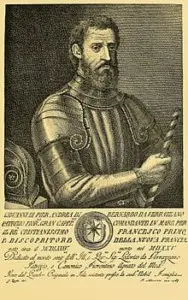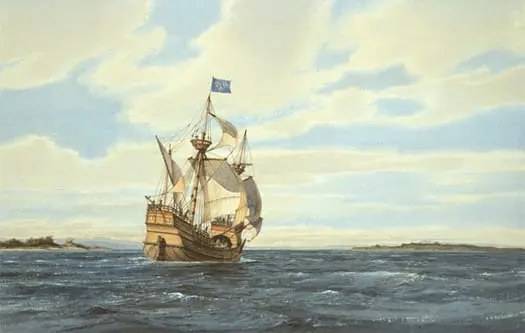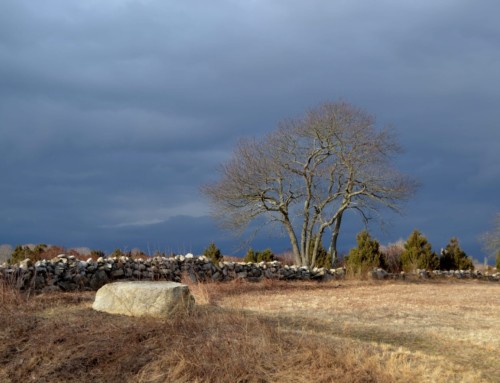The land that is now the State of Rhode Island was first settled by Europeans in July 1621, however, this was not the first time that Europeans had visited and spent time in the area. That distinction belongs to Giovanni da Verrazzano and the crew of La Dauphine who explored the area in 1524 and spent 15 days with members of the Narragansett and Wampanoag Tribes, leaving behind a detailed account of their journey for future generations.
While no official record of his birth has been found, the consensus among scholars and historians is that Giovanni da Verrazzano was born in Val di Greve in the Republic of Florence c. 1485. [1] Although much is known about his travels due in large part to the extensive and highly detailed accounts of his journeys, relatively little is known about Verrazzano’s life. Around the age of 21, Verrazzano settled in the French port of Dieppe and began his career as an explorer.[2] In 1523, upon the request of Francis I, King of France, and with the financial support of banks in Lyons and Rouen, Verrazzano set sail for the New World with a fleet of four ships.[3]
After violent weather caused the loss of two ships, the two that remained, La Dauphine and La Normande were forced to return to France. The two ships launched in the final weeks of 1523, however, further issues forced La Normande to return to France once more and La Dauphine finally departed from Portugal on January 17, 1524.[4]
The one ship which survived the journey to North America, La Dauphine, was built at the Royal Dockyard in Le Havre, Normandy, France in 1518. The vessel could hold 50 men and was named after the Dauphin of France, Francis III, Duke of Brittany, heir to the French throne.[5] During the 1524 journey, La Dauphine was piloted by Antoine de Conflans.[6]
La Dauphine first encountered North America when it reached Cape Fear in modern-day North Carolina at the beginning of March. In a letter to the King of France, Verrazzano stated the King that he believed Pamlico Sound on the Carolina coast was the beginning of the Pacific Ocean.[7] That the landscape of the continent was unknown is apparent, given that Verrazzano did not notice the entrances to the Chesapeake Bay or the mouth of the Delaware River, and he mistakenly believed the entrance to the Hudson River was a large lake.[8] After moving up the Atlantic coast and sailing along Long Island, La Dauphine ventured past a triangular island, now known as Block Island, which reminded him of the Isle of Rhodes in Greece.[9] In his letter to Francis I, the explorer wrote:

It has since been speculated that Roger Williams, a well-read scholar, was aware of Verrazzano’s journey and may have interpreted the account as Verrazzano naming Aquidneck Island instead of Block Island and hence, Aquidneck Island became “Rode Island.”[11] Despite describing Block Island as similar to Rhodes, Verrazzano actually named the island in honor of the King’s mother, Aloysia.[12]
After passing Block Island, where La Dauphine encountered unfavorable weather, they entered Narragansett Bay where they were greeted by a gathering of Wampanoag and Narragansett people. Once the ship crossed into the Bay, it was surrounded by about twenty canoes holding many Native Americans “uttering various cries of wonderment” who guided them to land.[13] Verrazzano anchored La Dauphine at present-day Newport Harbor (much debate has been brought about regarding the exact location of the ship’s landing) and the crew stayed among the Native Wampanoag people for 15 days.[14] During this extended stay, the sailors explored the land at length, journeying as far as thirty miles and reaching plains which were later Pawtucket, Rhode Island.[15]
Giovanni da Verrazzano left highly-detailed accounts of the Native Americans who welcomed him in Rhode Island, providing historians with a plethora of information. According to his depiction of the first encounter, the Natives stared at the ship in wonder and “all together they raised a loud cry which meant that they were joyful.”[16] In comparing the various tribes he encountered on his journey, Verrazzano claimed “these people are the most beautiful and have the most civil customs that we have found on this voyage.”[17]
Verrazzano also noted that the Wampanoags were generally uninterested in the items which Europeans valued highly at the time, indicating: “They did not appreciate cloth of silk and gold, nor even of any other kind, nor did they care to have them; the same was true for metals like steel and iron, for many times when we showed them some of our arms, they did not admire them, nor ask for them, but merely examined the workmanship.”[18] The explorer often spoke highly of the individuals he encountered in Rhode Island, proclaiming that “they are very generous and give away all they have.”[19] Perhaps most interestingly, he also noted that “they live a long time, and rarely fall sick; if they are wounded, they cure themselves with fire without medicine; their end comes with old age.”[20]
Giovanni da Verrazzano’s accounts of the interior land which would later be known as Rhode Island also provided the earliest recorded glimpse of the future state’s landscape. According to his retelling of their explorations, the crew often venture five to six leagues inland (15-18 miles) and “found it as pleasant as I can possibly describe, and suitable for every kind of cultivation grain, wine, or oil. For there the fields extend for twenty-five to thirty leagues (75-90 miles); they are open and free of any obstacles or trees, and so fertile that any kind of seed would produce excellent crops.”[21] Perhaps Verrazzano’s favorable depiction of the topography of the land would serve as inspiration for future explorations and settlement.
After La Dauphine’s 15-day stay in Rhode Island, the ship continued their trip up the North American coast where Verrazzano discovered Cape Cod Bay, a fact which was proven in the form of a map from 1529 which clearly shows the outline of Cape Cod.[22] The crew then continued their journey northward along the coast of modern-day Maine, Nova Scotia, and Newfoundland, at which time they began the long expedition back to Europe. La Dauphine returned to France by July 8, 1524.
Despite his achievements and the notoriety they brought Verrazzano, the explorer’s fate is ultimately unknown. In fact, there are several conflicting accounts of how his life came to an end. One version suggests that during a subsequent visit to North America in 1528, Verrazzano made stops on several islands, including, perhaps Guadeloupe, where he anchored and rowed ashore. It is said that Verrazzano was killed and eaten by the native Caribs while his fleet, who were anchored out of gunshot range, could not prevent his death.[23] Older historical accounts, however, speculate that Verrazzano was actually the same person as Jean Fleury who was executed for Piracy in Puerto del Pico, Spain.[24] Although the details of his life and death after 1524 are not entirely clear, it is known with certainty that Giovanni da Verrazzano is the first known European to have explored Rhode Island.
In 1975, the Rhode Island Legislature acknowledged Verrazzano’s accomplishment, passing a law to officially acknowledge April 21 as Dauphine Day, “in honor of the arrival of the “Dauphine” to Rhode Island in 1524.”[25]
[su_accordion class=””] [su_spoiler title=”Footnotes” open=”no” style=”default” icon=”plus” anchor=”” class=””]
- Buisseret, David, The Oxford Companion to World Exploration: M-Z, Topical Outline of Entries, Directory of Contributors, Index, Volume 2, (2007), pg. 332.
- Morison, Samuel Eliot, The European Discovery of America: the Northern Voyages, A.D. 500-1600, (New York, NY, 1971), pgs. 260-261.
- Ladurie, Emmanuel Le Roy, The Royal French State, 1460-1610, (Oxford,UK, 1987), pg. 127.
- Shaw, Edward R., Discoverers and Explorers, (New York, NY, 1900), pg. 103.
- The Maritime Museum of Rouen, Reconstructing La Dauphine, https://web.archive.org/web/20071012164148/http://www.musee-maritime-rouen.asso.fr/LANGUES/angleterre.html.
- The Mariners’ Museum, Exploration Through the Ages, “Giovanni da Verrazzano,” https://web.archive.org/web/20071019184158/http://www.mariner.org/exploration/index.php?type=explorer&id=22.
- National Humanities Center, “Giovanni da Verrazzano, Letter to King Francis 1 of France, 8 July 1524, reporting on his voyage to the New World, http://nationalhumanitiescenter.org/pds/amerbegin/contact/text4/verrazzano.pdf.
- National Humanities Center, “Giovanni da Verrazzano, Letter to King Francis 1 of France, 8 July 1524, reporting on his voyage to the New World, http://nationalhumanitiescenter.org/pds/amerbegin/contact/text4/verrazzano.pdf, pg. 3.
- Morison, Samuel Eliot, The European Discovery of America: the Northern Voyages, A.D. 500-1600, (New York, NY, 1971), pg. 303.
- National Humanities Center, “Giovanni da Verrazzano, Letter to King Francis 1 of France, 8 July 1524, reporting on his voyage to the New World, http://nationalhumanitiescenter.org/pds/amerbegin/contact/text4/verrazzano.pdf, pg. 6.
- Morison, Samuel Eliot, The European Discovery of America: the Northern Voyages, A.D. 500-1600, (New York, NY, 1971), pg. 303.
- National Humanities Center, “Giovanni da Verrazzano, Letter to King Francis 1 of France, 8 July 1524, reporting on his voyage to the New World, http://nationalhumanitiescenter.org/pds/amerbegin/contact/text4/verrazzano.pdf, pg. 6.
- National Humanities Center, “Giovanni da Verrazzano, Letter to King Francis 1 of France, 8 July 1524, reporting on his voyage to the New World, http://nationalhumanitiescenter.org/pds/amerbegin/contact/text4/verrazzano.pdf, pg. 6.
- National Humanities Center, “Giovanni da Verrazzano, Letter to King Francis 1 of France, 8 July 1524, reporting on his voyage to the New World, http://nationalhumanitiescenter.org/pds/amerbegin/contact/text4/verrazzano.pdf, pg. 7.
- Morison, Samuel Eliot, The European Discovery of America: the Northern Voyages, A.D. 500-1600, (New York, NY, 1971), pg. 307.
- National Humanities Center, “Giovanni da Verrazzano, Letter to King Francis 1 of France, 8 July 1524, reporting on his voyage to the New World, http://nationalhumanitiescenter.org/pds/amerbegin/contact/text4/verrazzano.pdf, pg. 6.
- National Humanities Center, “Giovanni da Verrazzano, Letter to King Francis 1 of France, 8 July 1524, reporting on his voyage to the New World, http://nationalhumanitiescenter.org/pds/amerbegin/contact/text4/verrazzano.pdf, pg. 7.
- National Humanities Center, “Giovanni da Verrazzano, Letter to King Francis 1 of France, 8 July 1524, reporting on his voyage to the New World, http://nationalhumanitiescenter.org/pds/amerbegin/contact/text4/verrazzano.pdf, pg. 7.
- National Humanities Center, “Giovanni da Verrazzano, Letter to King Francis 1 of France, 8 July 1524, reporting on his voyage to the New World, http://nationalhumanitiescenter.org/pds/amerbegin/contact/text4/verrazzano.pdf, pg. 7.
- National Humanities Center, “Giovanni da Verrazzano, Letter to King Francis 1 of France, 8 July 1524, reporting on his voyage to the New World, http://nationalhumanitiescenter.org/pds/amerbegin/contact/text4/verrazzano.pdf, pg. 8.
- National Humanities Center, “Giovanni da Verrazzano, Letter to King Francis 1 of France, 8 July 1524, reporting on his voyage to the New World, http://nationalhumanitiescenter.org/pds/amerbegin/contact/text4/verrazzano.pdf, pg. 8.
- Deyo, Simeon L., History of Barnstable County, Massachusetts, 1620-1637-1686-1890, (New York, NY, 1890), pg. 952.
- Wroth, Lawrence C., The Voyages of Giovanni da Verrazzano, 1524-1528, (New Haven, CT, 1970), pg. 237.
- Murphy, Henry Cruse, The Voyage of Verrazzano: a Chapter in the Early History of Maritime Discovery in America, (Albany, NY, 1875), pg. 149.
- Rhode Island General Laws, 25-2-17. Dauphine Day, http://webserver.rilin.state.ri.us/Statutes/TITLE25/25-2/25-2-17.HTM.
[/su_spoiler] [/su_accordion]






